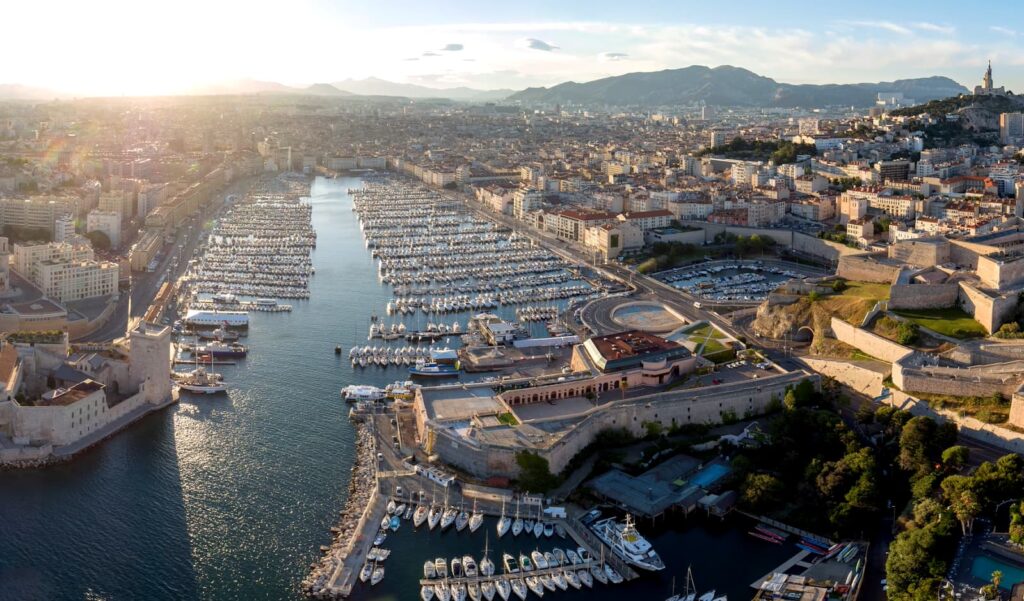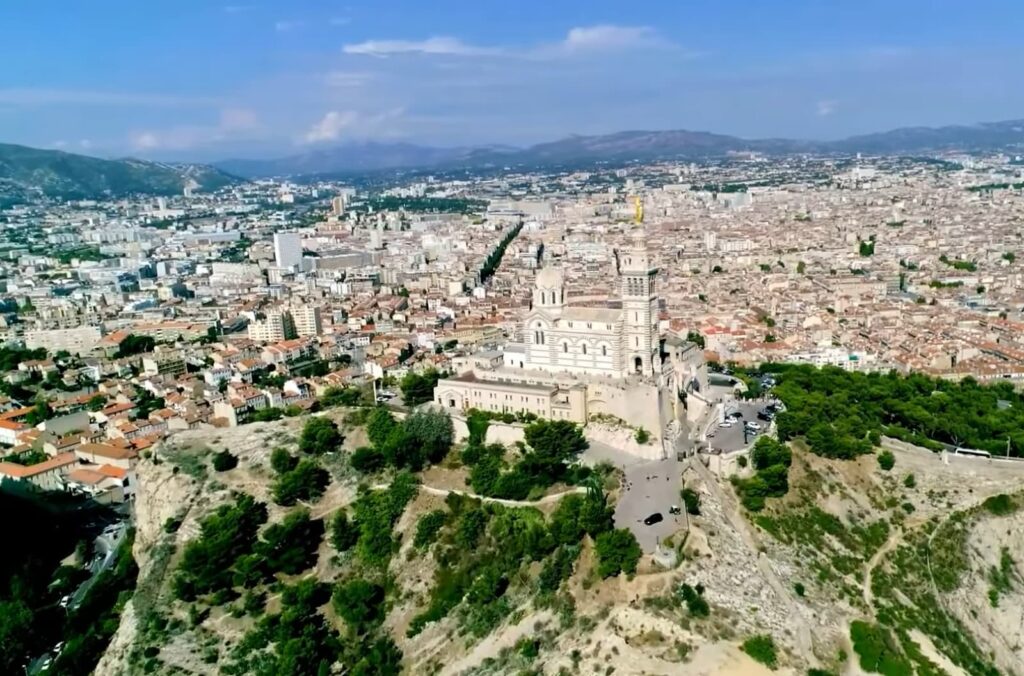A Brief History of Marseille
Marseille, France traces its origins back to around 600 BC when it was established as the Greek colony of Massalia by settlers from Phocaea, modern-day Foca, Turkey. Massalia quickly rose to prominence as a leading Greek polis in the Hellenized region of southern Gaul. Aligning itself with the Roman Republic during the Second Punic War (218-201 BC), Marseille successfully defended its independence and commercial dominance in the western Mediterranean, even as Rome expanded its influence across Western Europe and North Africa. However, in 49 BC, during Caesar’s Civil War, Marseille lost its autonomy following the Roman Siege of Massilia, siding with the faction opposing Julius Caesar.
Under Roman rule, Marseille flourished as an urban center and played a significant role in the spread of Christianity during the Western Roman Empire. Despite facing challenges such as the capture by the Visigoths in the 5th century AD and subsequent decline after being sacked by Charles Martel, Marseille remained a pivotal maritime trading hub. It became part of the County of Provence in the 10th century but suffered setbacks including the Black Death in the 14th century and a sack by the Crown of Aragon in 1423. Renewed prosperity came in the mid-15th century with ambitious building projects undertaken by René of Anjou, Count of Provence, who fortified the city.
During the 16th century, Marseille’s naval fleet, combined with the forces of the Franco-Ottoman alliance, posed a threat to rival ports and navies, including those of Genoa and the Holy Roman Empire. The city endured significant population loss during the Great Plague of Marseille in 1720 but rebounded by the mid-18th century. Marseille emerged as a key player in the French Revolution, giving birth to France’s national anthem, La Marseillaise, in 1792.
In more recent history, Marseille faced challenges during World War II, enduring the occupation by Nazi Germany. The city also played a role in the Industrial Revolution and served as a base for the establishment of the French Empire, including territories such as French Algeria. Delving into Marseille’s rich history unveils captivating stories of its prominent figures, such as the intriguing tale of Désirée Clary.
Early Human Settlements in Marseille: Prehistoric Timeline

For nearly 30,000 years, Marseille and its surrounding areas have been inhabited by humans. Evidence of this ancient presence is abundant, with Palaeolithic cave paintings discovered in the submerged Cosquer Cave near the Calanque of Morgiou, dating back to a period between 27,000 and 19,000 BC. Additionally, recent excavations conducted near the railway station have revealed neolithic brick dwellings dating back to around 6000 BC. These discoveries offer valuable insights into the early human civilizations that once thrived in the region, shedding light on their lifestyles and cultural practices during prehistoric times.
Massalia: Greek Colony to Roman Integration
In the heart of what is now Marseille, France, the ancient city of Massalia was established around 600 BC by Greek settlers from Phocaea, located on the Aegean coast of what is today Foça, Turkey. This foundational event is documented in historical accounts, including Thucydides’s chronicles of the Peloponnesian War, highlighting the Phocaeans’ struggle against Carthaginian opposition. The narrative of Massalia’s origins is also enriched by legends, notably the story of Protis and Gyptis. Protis, a Phocaean explorer, was seeking a new trading post and stumbled upon Lacydon cove. He won the favor of Gyptis, the daughter of the local Ligurian chief, during a marriage banquet, marking the beginning of Massalia on the site near this protective cove.
The city blossomed into a significant trade hub, known for its strategic location and vibrant trade activities, peaking in the 4th century BC with a bustling population and a robust governance structure. It was notable for its aristocratic republicanism, religious temples dedicated to Apollo and Artemis, and its minting of drachmas. Massalia’s traders pioneered overland routes extending to the Baltic Sea, exporting a variety of local goods.
Pytheas, a renowned citizen of Massalia, made significant contributions to astronomy and navigation, exploring as far north as the Arctic Circle. His observations laid the groundwork for understanding the relationship between the moon’s phases and tides, though his proposed sea route to Cornwall was not pursued further due to the efficiency of overland trade.
The city also played a crucial role in facilitating trade between Gaul and Rome, becoming a vital link in the supply chain for Roman goods. However, its strategic importance also made it a target during conflicts, such as the Punic Wars and Julius Caesar’s campaigns. Despite initially resisting Caesar, Massalia was eventually subdued, losing its trade empire but maintaining a degree of autonomy under Roman rule.
The transition to Roman oversight saw changes in governance and social norms, including new laws and the introduction of Christianity, with figures like Mary Magdalen playing a key role in the city’s religious history. The legacy of Massalia as a bridge between cultures and a center of trade and exploration underscores its significance in ancient Mediterranean history.
From the Middle Ages to the Renaissance
Marseille maintained stability and prosperity well into the 8th century, seemingly unaffected by the Roman Empire’s decline, likely due to its robust Phocaean defensive walls. Despite falling to the Visigoths in the 5th century, it emerged as a significant Christian intellectual hub, home to scholars like John Cassian, Salvian, and Sidonius Apollinaris. By the 6th century, Marseille had established itself as a crucial Mediterranean commercial hub. Its economic and infrastructural legacy from the Phocean and Roman eras, including forums and baths, persisted until the 7th century. However, in 739, Charles Martel’s forces dramatically impacted Marseille’s prosperity for refusing to accept the appointed governor, marking a period of decline that lasted until the 10th century due to continuous attacks from Greeks and Saracens.
The revival of Marseille’s wealth and trade prominence in the 10th century was significantly influenced by the Counts of Provence. Governance under a consul was introduced, and though initially resistant, Marseille recognized the suzerainty of Raymond Berengar IV of Provence by 1243. Post-Raymond’s death, his daughter Beatrice’s marriage to Charles, brother of Louis IX of France, led to administrative changes that sparked discontent and rebellions, notably in 1248 and again in 1262. Despite these challenges, Charles managed to suppress the uprisings, and Marseille saw a resurgence in trade and no further major conflicts for a time. However, the bubonic plague in 1348 and subsequent Aragonese attacks in 1423 severely affected the city’s population and trade.
The arrival of René of Anjou in 1437 marked a new chapter for Marseille, establishing it as a formidable fortified city outside Paris and enhancing its strategic and trading stature. Significant developments included the construction of port defenses and the flourishing of trade, attributed to the influential guilds and the founding of the Corporation of Fisherman by King René.
Despite being united with Provence in 1481 and its incorporation into France, Marseille was known for its rebellious spirit against central governance. Noteworthy events include Francis I’s visit, intrigued by a rhinoceros intended for Pope Leo X but shipwrecked, and the subsequent construction of the Chateau d’If fortress. The city also played a crucial role as a naval base for the Franco-Ottoman alliance in 1536. However, Marseille faced further adversities, including a plague outbreak in the late 16th century and a local uprising against the governor, quelled by King Louis XIV, leading to the construction of significant forts and a naval arsenal in the harbor.
Marseille: 18th & 19th Century Shifts

Throughout the 18th century, Marseille fortified its status as France’s premier military port in the Mediterranean through enhancements to its port defenses. The city faced a devastating event in 1720 when the last significant outbreak of the plague, a continuation of the Black Death, claimed the lives of 100,000 people in Marseille and the surrounding regions. This period also saw Jean-Baptiste Grosson, a royal notary, compile the historical Almanac of Marseille from 1770 to 1791. His work, a comprehensive collection of the city’s antiquities and monuments, became a vital reference for understanding Marseille’s historical and architectural heritage.
The fervor of the French Revolution was wholeheartedly adopted by Marseille’s citizens, who, in 1792, sent a contingent of 500 volunteers to Paris to support the revolutionary cause. The anthem they sang during their march, “La Marseillaise,” would later be adopted as France’s national anthem, symbolizing the city’s significant contribution to the revolution.
The 19th century marked a period of industrial innovation and expansion in manufacturing within the city, further propelled by the rise of the French Empire and its territorial conquests from 1830 onwards, particularly in Algeria. These developments significantly boosted Marseille’s maritime trade and overall prosperity. The city’s strategic importance was further underscored by the opening of the Suez Canal in 1869, which heightened maritime expeditions. This era of growth and prosperity is commemorated in several of Marseille’s monuments, including the Napoleonic obelisk at Mazargues and the royal triumphal arch at the Place Jules Guesde, each standing as testaments to Marseille’s rich and tumultuous history during the 18th and 19th centuries.
Marseille: Colonial Glory to War (1900-1945)
- In the first half of the 20th century, Marseille flaunted its status as a “port of the empire” through colonial exhibitions in 1906 and 1922. The grand staircase of the railway station, symbolizing French colonial conquests, stands as a testament to this era. In 1934, Alexander I of Yugoslavia visited the port, only to tragically meet his end at the hands of Vlado Chernozemski;
- Amidst the interwar period, Marseille gained notoriety for its sprawling organized crime networks. Simon Kitson’s research highlights how corruption seeped into local authorities, including the police;
- The outbreak of World War II brought devastation to Marseille. Bombed by German and Italian forces in 1940, the city endured occupation from November 1942 to August 1944. The horrors of “Action Tiger” unfolded on January 22, 1943, as over 4,000 Jews were seized and deported to Poland for extermination. The Old Port fell victim to German destruction in the same month;
- Liberation finally came on August 29, 1944, as General Joseph de Goislard of Monsabert led French forces, aided by limited American support, to free Marseille as part of Operation Dragoon. This victory paralleled the liberation of other major French cities, marking the end of a tumultuous chapter in Marseille’s history.
Marseille’s Post-World War II Reconstruction and Immigration
Following World War II, Marseille underwent extensive reconstruction throughout the 1950s. Governments of East and West Germany, along with Italy, paid substantial reparations, including compound interest, to compensate civilians affected by the war.
Starting in the 1950s, Marseille became a primary entry point for over a million immigrants to France. In 1962, there was a significant influx from newly independent Algeria, including approximately 150,000 returning Algerian settlers known as “pieds noirs.” Many immigrants chose to settle in the city, contributing to its diverse and vibrant market.
Conclusion
The rich tapestry of Marseille’s history unfolds a captivating saga of human resilience and evolution. From its inception as the Greek colony of Massalia to its transformation into a bustling, multicultural hub in contemporary times, this enduring city has seamlessly embraced change and weathered numerous adversities. With the prowess of resilience woven into its cultural and social fabric, the city stands as a testament to the enduring spirit of humankind. Through its varied past lies a profound tale, revealing insights about world history, the rise and fall of empires, socio-economic transformations, and the indomitable quest for progress and prosperity.